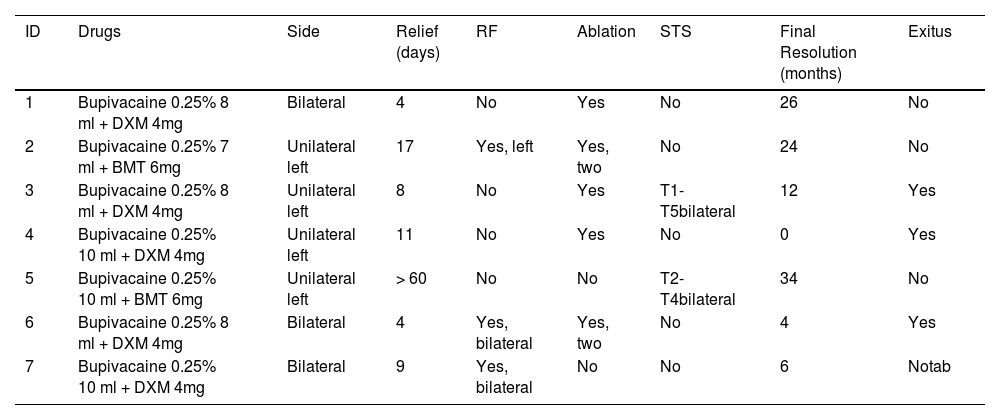Electrical storm is a life-threatening emergency with a high mortality rate. When acute conventional treatment is ineffective, stellate ganglion block can help control arrhythmia by providing a visceral cervicothoracic sympathetic block. The objective of this study is to assess the effectiveness and safety of stellate ganglion block in the management of refractory arrhythmic storm.
MethodFollow-up of a cohort of patients with refractory electrical storm that met the criteria for performing stellate ganglion block. The block was ultrasound-guided at C6 using local anaesthetic and a steroid – left unilateral first, bilateral if no response, followed by fluoroscopy-guided radiofrequency ablation at C7 if there was a favourable response but subsequent relapse.
ResultsSeven patients were included. The in-hospital mortality rate was 14.29%. Four patients received unilateral and 3 bilateral stellate ganglion block. Six were ablated and 1 received an implantable cardioverter-defibrillator. Electrical storm was controlled temporarily beyond the effect of the local anaesthetic in all patients. Three patients underwent radiofrequency ablation and 2 underwent surgical thoracic sympathectomy. The only side effect was Horner’s syndrome, which was observed in all cases after administering a stellate ganglion block with local anaesthetic. Two patients died after discharge and 4 are alive at the time of writing, 3 of them have not been re-admitted for ventricular events for more than 2 years.
ConclusionUltrasound-guided stellate ganglion block is an effective and safe complement to standard cardiological treatment of refractory electrical storm.
La tormenta arrítmica es una urgencia vital. Cuando el tratamiento agudo convencional no es efectivo, el bloqueo del ganglio estrellado puede contribuir al control de la arritmia al proporcionar un bloqueo simpático visceral cervicotorácico. El objetivo de este estudio es valorar la efectividad y seguridad del bloqueo ecoguiado del ganglio estrellado para el tratamiento de la tormenta arrítmica refractaria.
MétodoSeguimiento de una cohorte de pacientes con tormenta arrítmica que cumplen criterios para el bloqueo del ganglio estrellado.El bloqueo fue realizado guiado con ecografía a nivel C6 utilizando anestésico local y esteroide, primero en lado izquierdo y, si no respuesta, seguidamente en el lado derecho bilateralmente, y seguido de radiofrecuencia convencional guiada mediante fluoroscopia a nivel C7 si la respuesta al bloqueo fue faroable de forma transitoria con reaparición posterior de la arrítmia.
ResultadosSe incluyó a siete pacientes, con una mortalidad durante el ingreso del 14.29%. Cuatro pacientes recibieron bloqueo unilateral y tres bloqueo bilateral del ganglio estrellado. Seis recibieron ablación cardíaca y a uno de ellos se implantó un desfibrilador cardíaco automático. La tormenta arrítmica fue controlada termporalmente en todos los casos más allá de la duración del efecto anestésico local. Tres pacientes se sometieron a ablación por radiofrecuencia del ganglio estrellado y dos a simpatectomía torácica endoscópica del ganglio estrellado. El único efecto adverso observado durante el estudio fue el síndrome de Horner después del bloqueo anestésico del ganglio estrellado. Dos pacientes fallecieron antes del alta y cuatro continúan de alta; tres de ellos sin reingreso posterior debido a eventos ventriculares desde hace más de dos años.
ConclusiónEl bloqueo ecoguiado del ganglio estrellado es una técnica efectiva y segura para el tratamiento de la tormenta arrítmica refractaria como complemento al tratamiento cardiológico habitual.








